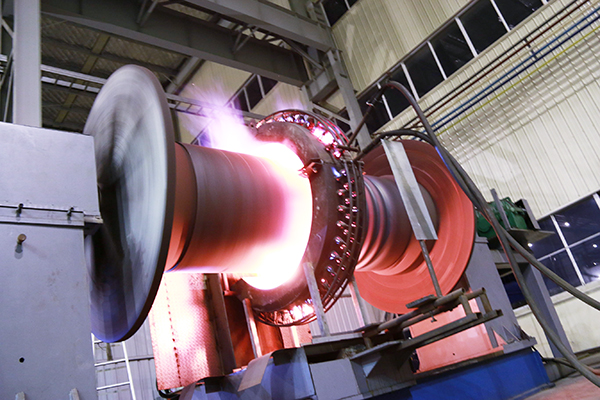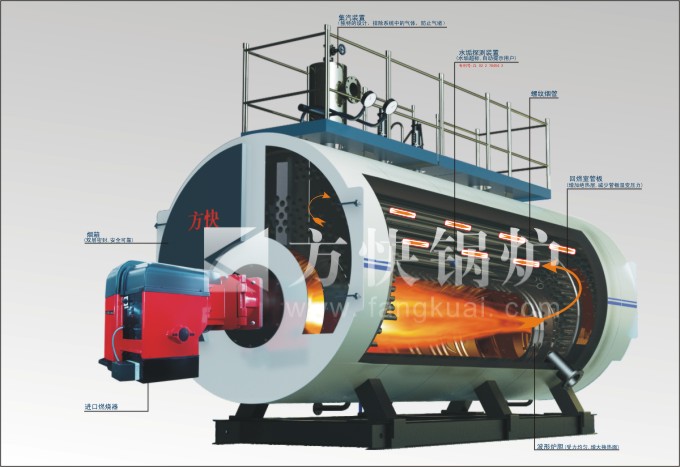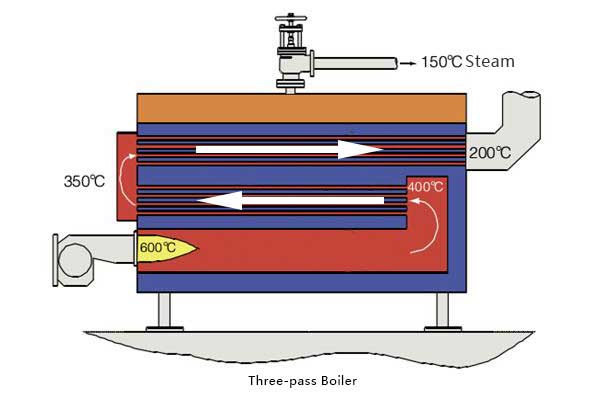Fire tube steam boilers are characterized by their shell-and-tube configuration where combustion gases flow inside tubes surrounded by water.
1. Core Structural Configuration (Shell & Tube):
Pressure Vessel: A large, cylindrical shell forms the primary pressure boundary, containing water and saturated steam.
Heating Surface: One or more furnace tubes (also called flues or fire tubes) pass through this water-filled shell. Combustion occurs within the first (furnace) tube.
Flue Gas Path: Hot combustion gases travel the length of the furnace tube(s), reverse direction at the end (often in a combustion chamber or “smoke box”), and pass back through multiple smaller fire tubes (or “smoke tubes”) before exiting to the chimney.
Three-pass fire tube steam boiler
2. Heat Transfer Mechanism:
Heat Source: Combustion gases inside the tubes.
Heat Sink: Water surrounding the tubes outside the tubes.
Mode: Primarily Convection from gases to tube wall; Conduction through the tube wall; Convection/Nucleate Boiling from tube wall to water. Tube surface area is the critical heat transfer surface.
3. Output Medium & Operation:
Steam Generation: Heat transfer boils water, producing saturated steam that collects in the upper portion of the shell. Operating pressure determines saturation temperature (e.g., 10 barg ≈ 184°C, 25 barg ≈ 224°C).
Hot Water Generation: Heat transfer raises water temperature below boiling point. Operation requires a pressurization system to prevent flashing and maintain liquid state at desired outlet temperature.

4. Fire tube Steam Boiler Pressure & Temperature Limits:
Fundamental Limitation: Water/steam pressure is contained within the large-diameter shell. As pressure increases:
Required shell wall thickness increases significantly.
Thermal stress and mechanical stress concentrations at tube-to-tube-sheet joints become critical.
Maintaining a large steam space volume becomes inefficient and cumbersome.
Practical Pressure Cap: Around 3.8 MPa (38 barg / ~550 psig). Operating near this cap generally requires specialized designs (e.g., multiple furnaces/tubes, reinforced construction).
Output Temperature Cap: Limited to Saturated Steam Temperatures corresponding to the pressure cap. Producing superheated steam efficiently within a fire tube design is very difficult and uncommon due to space constraints and material limitations within the steam space.
5. Fire tube Steam Boiler Capacity Range:
Primarily suited for lower steam capacities (< ~25,000 kg/h or < ~50,000 lb/hr). Flow capacity is constrained by the physical size of the shell relative to required heating surface area.

6. Common Variants:
“Scotch” Marine Boiler: Characterized by one or two large internal furnace tubes surrounded by many small fire tubes. Highly efficient packaging.
”Dry-Back” vs. “Wet-Back”: Refers to the combustion chamber reversal section. Dry-back has an external, refractory-lined chamber. Wet-back has the chamber surrounded by water, improving efficiency slightly.
“Firebox” Boiler: A variation often seen in locomotives/older designs with a rectangular firebox at one end connected to tubes.
7. Critical Operational Considerations:
Water Quality: Paramount. Poor feedwater causes scale inside tubes (insulating tubes, causing overheating) and corrosion/pitting of tubes and shell.
Start-up Time: Significantly faster than larger water tube steam boilers due to lower water volume and massive steel structure.
Reliability & Simplicity: Generally robust and relatively simple to operate and maintain for their intended pressure range.
Footprint: Can be compact (“packaged” designs) but constrained by shell diameter.
Fire tube steam boilers use a simple shell‑and‑tube design: hot combustion gases pass through tubes surrounded by water. They’re built for moderate pressures (up to about 3.8 MPa) and produce saturated steam at modest capacities. Thanks to their straightforward construction, they start up quickly and run reliably—but they need good water treatment and aren’t meant for pressures above 4 MPa or for superheated steam. Water‑tube steam boilers handle those tougher jobs.
Get your best price
Quickly compare 3 FREE quotes
- Engineer quick quote
- The overall delivery speed is fast
- Financial choice
- Low installation costs and cost savings
25 years+ of boiler R&D
More than 20 innovative technologies

